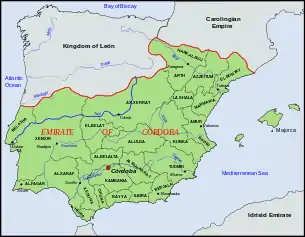Emirate of Córdoba
The Emirate of Córdoba (Arabic: إمارة قرطبة, Imārat Qurṭubah) was a Medieval Islamic kingdom in the Iberian Peninsula. Its founding in the mid eighth century would mark seven hundred years of independent Muslim rule in what is now Spain and Portugal.
Emirate of Córdoba إمارة قرطبة Imārat Qurṭubah (Arabic) | |||||||||
|---|---|---|---|---|---|---|---|---|---|
| 756–929 | |||||||||
 Emirate of Córdoba in 929 (green) | |||||||||
| Capital | Córdoba | ||||||||
| Common languages | Andalusian Arabic, Berber, Mozarabic, Medieval Hebrew | ||||||||
| Religion | Sunni Islam, Judaism, Roman Catholicism | ||||||||
| Government | Islamic absolute Monarchy | ||||||||
| History | |||||||||
• Abd al-Rahman I proclaimed Emir of Córdoba | 15 May 756 | ||||||||
| 16 January 929 | |||||||||
| |||||||||
| Today part of | |||||||||
| Historical Arab states and dynasties |
|---|
 |
The territories of the Emirate, located in what the Arabs called Al-Andalus, had formed part of the Umayyad Caliphate since the early eighth century. After the caliphate was overthrown by the Abbasids in 750, the Umayyad prince Abd ar-Rahman I fled the former capital of Damascus and established an independent emirate in Iberia in 756. The provincial capital of Córdoba (Arabic: قرطبة Qurṭuba) was made the capital, and within decades grew into one of the largest and most prosperous cities in the world. After initially recognizing the legitimacy of the Abbasid Caliphate of Baghdad, in 929 Emir Abd ar-Rahman III declared the caliphate of Córdoba, with himself as caliph.
History
Roderic was a Visigothic emperor who ruled the area of Spain from 710-712 AD, later referred to by the Arabs, as "Al-Andalus". The Umayyad Empire had previously conducted small raids on the southern tip of Spain against the Visigoths, but full scale conquest did not begin until April of 711, when an army led by Tariq ibn Ziyad crossed the narrow channel that separated southern Spain from North Africa; the area is today known as Gibraltar, from the Arabic Jabal Ṭāriq (جبل طارق), meaning "mountain of Ṭāriq".
After crossing into Spain, Tariq's troops clashed with Roderic's small army at the banks of the Wadi-Lakku river. Visigothic forces were defeated and Roderic was killed, leaving an open path into Spain, and by extension Europe, for the Umayyad Empire to conquer. After the Umayyad conquest of Hispania in 711–718, the Iberian Peninsula was established as a province under the Umayyad Caliphate. The rulers of this province established their capital in Córdoba and received from the Umayyad Caliphate the title of wali or emir.[2]
In 756, Abd al-Rahman I, a prince of the deposed Umayyad royal family, refused to recognize the authority of the Abbasid Caliphate and became an independent emir of Córdoba. He had been on the run for six years after the Umayyads had lost the position of caliph in Damascus in 750 to the Abbasids. Intent on regaining a position of power, he defeated the existing Muslim rulers of the area who had defied Umayyad rule and united various local fiefdoms into an emirate.[3] However, this first unification of al-Andalus under Abd al-Rahman still took more than twenty-five years to complete (Toledo, Zaragoza, Pamplona, Barcelona).
For the next century and a half, his descendants continued as emirs of Córdoba, with nominal control over the rest of al-Andalus and sometimes even parts of western Maghreb, but with real control always in question, particularly over the marches along the Christian border, their power vacillating depending on the competence of the individual emir. For example, the power of emir Abdullah ibn Muhammad al-Umawi (c. 900) did not extend beyond Córdoba itself.
Upon the ascent to the throne of Abd al-Rahman III, who came to power in 912, the political decline of the emirate was obvious. Abd al-Rahman III rapidly restored Umayyad power throughout al-Andalus and extended it into western North Africa as well. In 929, to impose his authority and end the riots and conflicts that ravaged the Iberian Peninsula, he proclaimed himself caliph of Córdoba, elevating the emirate to a position of prestige not only in comparison to the Abbasid caliph in Baghdad but also the Shia Fatimid caliph in Tunis, with whom he was competing for control of North Africa. The Emirate of Cordoba gradually lost power and in 1492 Granada was taken by the Christians and Muslim influence dissolved.[4]
Umayyad Emirs of Córdoba
- Abd ar-Rahman I, 756–788
- Hisham I, 788–796
- al-Hakam I, 796–822
- Abd ar-Rahman II, 822–852
- Muhammad I, 852–886
- al-Mundhir, 886–888
- Abdallah ibn Muhammad, 888–912
- Abd ar-Rahman III, 912–929
See also
References
- Azizur Rahman, Syed (2001). The Story of Islamic Spain. Goodword Books. p. 129. ISBN 978-81-87570-57-8.
[Emir Abdullah died on] 16 Oct., 912 after 26 years of inglorious rule leaving his fragmented and bankrupt kingdom to his grandson ‘Abd ar-Rahman. The following day, the new sultan received the oath of allegiance at a ceremony held in the "Perfect salon" (al-majils al-kamil) of the Alcazar.
- Catlos. Kingdoms of Faith. C. Hurst & Co. p. 29. ISBN 978-1-78738-003-5.
- Barton, 37.
- Bouchard, Constance Brittain, Chief Consultant. (Distinguished Professor of Medieval History, University of Akron) “Knights in History and Legend” Firefly Books Ltd.. 2009. ISBN 978-1-55407-480-8. Page 202